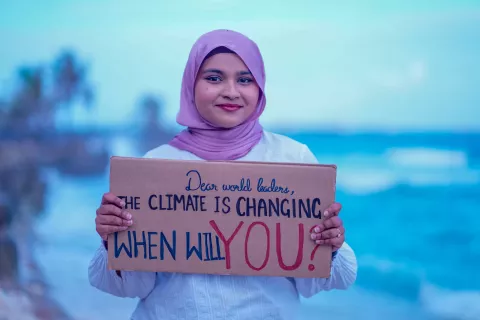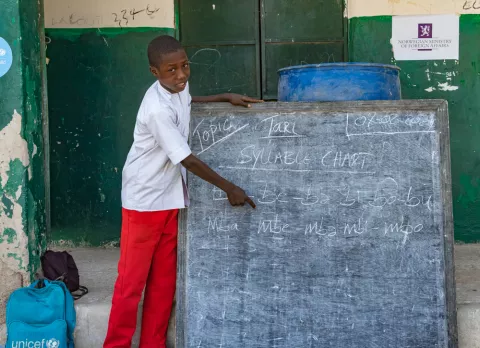Five years. That’s 1,825 sunrises, 43,800 hours and 2.6 million minutes to progress towards changing the face and reach of technology and innovation.
The clock starts ticking at the Generation Equality Forum this week. Heads of State, corporate and philanthropic CEOs, civil society leaders and youth activists will convene to make tangible and ambitious five-year commitments to achieve gender equality.
But there will be no gender equality without addressing the digital divide, where we see gender gaps in connectivity, skills, jobs and online safety.
In low- and middle-income countries, more than 50 per cent of women are offline, and women are 20 per cent less likely than men to own a smart phone. Even in middle- and higher-income countries, the digital divide persists: Only 14 per cent of girls who were top performers in science or mathematics expected to work in science and engineering, compared to 26 per cent of top-performing boys. And in a recent survey of 14,000 girls in 31 countries, more than half (58 per cent) had been harassed and abused online.
These gaps and experiences of gender-based violence in all forms – online and offline – span geographies and generations, and the digital gender gulf is growing wider among today’s youth.
Yet the digital and innovation revolution is an opportunity for dramatic change. It is against our own interest as humans, as communities and as nations to continue to allow tech to widen the gap between half of the population and the game-changing opportunities innovation can provide.
Digital inclusion, and specifically digital literacy, is becoming just as crucial to well-being and success as the ability to read and write.
Digital inclusion, and specifically digital literacy, is becoming just as crucial to well-being and success (to learn, to earn and to voice change) as the ability to read and write. Innovative financing mechanisms are key to unlocking more sustainable partnerships and funding flows for impact at scale.
Here’s what we as UNICEF, alongside our partners (Chloé, Clé de Peau Beauté, Criterion Institute, Finland, Ford Foundation, Girl Effect, Microsoft, Open Society Foundations, Pandora, UNCDF, Unilever Dove, US Agency for International Development, Vodafone Americas Foundation and Volta Capital) commit to advance, with girls and women collectively, towards impact in the next five years:
1. Design sustainable financing mechanisms and leverage impact investing to close the gender digital divide and end gender-based violence (GBV).
Private capital investment plays a transformative role in addressing the barriers for young people making the leap from education to employment. Yet, of the US$21 billion invested in these impacts, a very small portion has been intentionally allocated to addressing challenges specific to girls and young women.
We call for the design of a digital literacy equity outcomes fund shaped by what girls and young women want and funded by a blend of private and public capital. This fund will expand the promising pipeline of business and non-profit interventions that intentionally address gender gaps in learning and earning.
We also support women and girls’ rights organizations and feminist movement actors to engage and shape systems of public and private finance to end gender-based violence, including in humanitarian contexts. Engagement is towards recognizing GBV as a material risk, supporting GBV prevention innovations developed by women and girls’ rights organizations, using finance vehicles to support accountability on GBV prevention in workplaces and supply chains, and advancing fairer financing structures for girls and women’s rights organizations.
2. Invest in knowing more about girls’ and young women’s digital realities, and supporting the learning solutions they design, fit for their digital world.
We are not starting from zero. Let’s build upon the great advancements made in girls’ education for decades while reimagining new pathways of learning designed for and by girls and young women, fit for their digital realities and diversity.
Learning covers a wide range of competencies, such as computer literacy, robotics, artificial intelligence application, online safety, well-being and health, and social entrepreneurship. We need more non-profit and social business models across the globe, as well as more routine data platforms, to allow closer-to-real-time monitoring of when, where and how girls are connecting, as well as the challenges and opportunities they face.
3. Use technology as a solution to address gender-based violence.
Tech-facilitated harassment and discrimination faced by girls and women has become a pervasive form of gender-based violence. But technology can also be a solution to help address all forms of GBV.
For example, safe spaces for women and girls are a well-documented GBV service approach, providing key information, links to critical services, skills-building, peer connection and support. Yet, as access to physical safe spaces is often limited, particularly in the context of the COVID-19 pandemic, we must collectively design and launch technology tools and digital platforms that help reach girls and women with the same support.
We can do this by building on the vision of girls and women, the expertise of the tech industry, and the leadership of practitioners already working to prevent and respond to GBV, including by establishing virtual safe spaces.
The vision for Generation Equality is ambitious, but it is attainable – especially with advancements in technology and innovation. We have more than a thousand days to act on policies, programmes, partnerships that will positively impact our families, communities and the world. As we collectively align to deliver these signature Generation Equality commitments, we call on others to join us: Commit to placing girls and young women at the centre as the trailblazers they are.
Fayaz King is the Deputy Executive Director of Field Results and Innovation at UNICEF.





